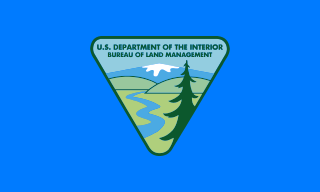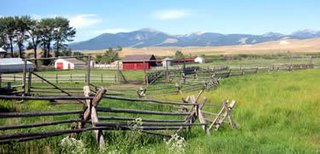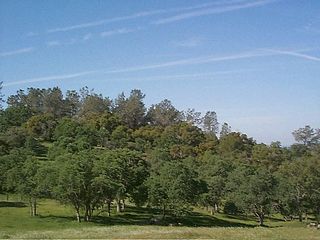
The Bureau of Land Management (BLM) is an agency within the United States Department of the Interior that administers more than 247.3 million acres (1,001,000 km2) of public lands in the United States which constitutes one eighth of the landmass of the country. President Harry S. Truman created the BLM in 1946 by combining two existing agencies: the General Land Office and the Grazing Service. The agency manages the federal government's nearly 700 million acres (2,800,000 km2) of subsurface mineral estate located beneath federal, state and private lands severed from their surface rights by the Homestead Act of 1862. Most BLM public lands are located in these 12 western states: Alaska, Arizona, California, Colorado, Idaho, Montana, Nevada, New Mexico, Oregon, Utah, Washington and Wyoming.
A pastoral lease is an arrangement used in both Australia and New Zealand where Crown land is leased by government generally for the purpose of grazing on rangelands.
A range war is a type of usually violent conflict, most commonly in the 19th and early 20th century in the American West. The subject of these conflicts was control of "open range", or range land freely used for cattle grazing, which gave the conflict its name. Typically they were disputes over water rights or grazing rights and cattle ownership.

Grazing rights is the right of a user to allow their livestock to feed (graze) in a given area.

Gutierrezia sarothrae is a species of flowering plant in the daisy family known by the common names broom snakeweed, broomweed, snakeweed, and matchweed. It is a subshrub native to much of the western half of North America, from western Canada to northern Mexico, and can be found in a number of arid, grassland, and mountain habitats. It can be toxic to livestock in large quantities, due mainly to the presence of saponins.

The Northern Basin and Range ecoregion is a Level III ecoregion designated by the United States Environmental Protection Agency (EPA) in the U.S. states of Oregon, Idaho, Nevada, Utah, and California. It contains dissected lava plains, rolling hills, alluvial fans, valleys, and scattered mountain ranges in the northern part of the Great Basin. Although arid, the ecoregion is higher and cooler than the Snake River Plain to the north and has more available moisture and a cooler climate than the Central Basin and Range to the south. Its southern boundary is determined by the highest shoreline of Pleistocene Lake Bonneville, which once inundated the Central Basin and Range. The western part of the region is internally drained; its eastern stream network drains to the Snake River system.
California Rangeland Trust is a nonprofit organization founded in 1998 by a group of innovative ranchers committed to conservation. The Rangeland Trust is now the largest land trust in California, having conserved nearly 300,000 acres (1,200 km2) of rangeland on 61 ranches across 24 counties.
Range Improvement Funds are money collected from livestock grazing on United States federal lands and used for rangeland improvements. The Bureau of Land Management calls these funds Range Improvement Funds and uses them solely for labor, materials, and final survey and design of projects to improve rangelands. The Forest Service calls these funds Range Betterment Funds and uses them for planning and building rangeland improvements.

August Ludwig "Gus" Hormay (1907–1999) developed and applied the concept of the rest-rotation grazing management system in areas of the Western United States. Rest-rotation rangeland management system uses deferred grazing to manage increased plant reproduction and maintenance, while providing grazing lands for both livestock and wildlife. Gus Hormay's rest-rotation management system was developed to increase a healthy plant community, watershed, soil and wildlife habitat, while at the same time increasing livestock production. It has been in use in various forms since the mid-1960s as a rangeland management tool.

A ranch is an area of land, including various structures, given primarily to the practice of ranching, the practice of raising grazing livestock such as cattle or sheep for meat or wool. The word most often applies to livestock-raising operations in Mexico, the Western United States and Western Canada, though there are ranches in other areas. People who own or operate a ranch are called ranchers, cattlemen, or stockgrowers. Ranching is also a method used to raise less common livestock such as elk, American bison or even ostrich, emu, and alpaca.

The Wild and Free-Roaming Horses and Burros Act of 1971 (WFRHBA), is an Act of Congress, signed into law by President Richard M. Nixon on December 18, 1971. The act covered the management, protection and study of "unbranded and unclaimed horses and burros on public lands in the United States."

The Santa Rita Experimental Range and Wildlife Area is the longest continuously active rangeland research facility and among the five oldest biological field stations in the United States. Located south of Tucson in Pima County, Arizona, the 52,000 acre Santa Rita Experimental Range (SRER) was founded in 1903 and administered by the United States Forest Service until 1987, when the University of Arizona College of Agriculture took over administration of the site. The mission at the SRER is "to advance research and education on the ecology and management of desert rangelands through the secure, long-term access to research areas, state-of-the-art facilities, new discoveries, and research legacies."
Grazing rights in Nevada covers a number of rangeland Federal and state laws and regulations applicable to the state of Nevada. Rangelands are distinguished from pasture lands because they grow primarily native vegetation, rather than plants established by humans. Ranchers may lease or obtain permits to use portions of this public rangeland and pay a fee based on the number and type of livestock and the period for which they are on the land.
Rangeland management is a professional natural science that centers around the study of rangelands and the "conservation and sustainable management [of Arid-Lands] for the benefit of current societies and future generations." Range management is defined by Holechek et al. as the "manipulation of rangeland components to obtain optimum combination of goods and services for society on a sustained basis."

The San Joaquin Biosphere Reserve is a UNESCO Biosphere Reserve located on the western slopes of the central Sierra Nevada mountains Madera County, California, about 20 miles (32 km) north of Fresno. This biosphere reserve represents the California steppe and California woodlands with blue oak, interior live oak. and digger pine.

The Central Plains Biosphere Reserve was a UNESCO Biosphere Reserve located in the western central Great Plains in north-central Colorado in the shortgrass prairie. The 6,210 hectares (24.0 sq mi) reserve encompasses the Central Plains Experimental Range (CPER) administered by the United States Department of Agriculture's Agricultural Research Service.

The Jornada Biosphere Reserve is a UNESCO Biosphere Reserve in southern New Mexico. It is one of three biosphere reserves representing the Chihuahuan Desert. The area extends from the crest of the San Andres Mountains, which are dominated by shrub woodlands, to the Jornada Plains characterized by semi-desert grasslands.













